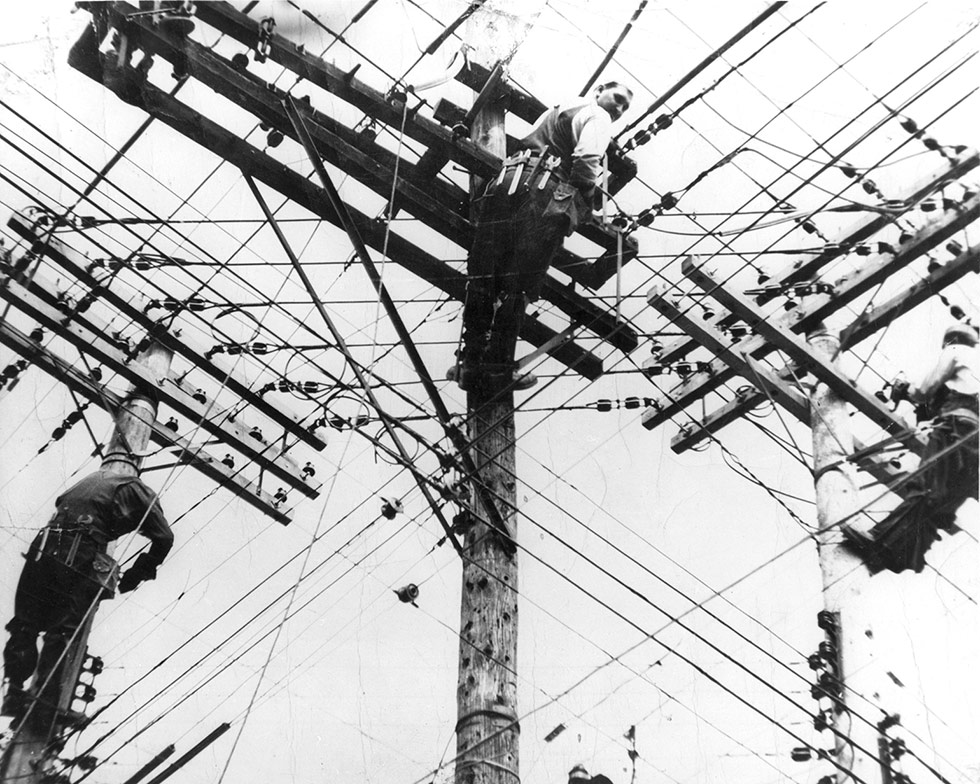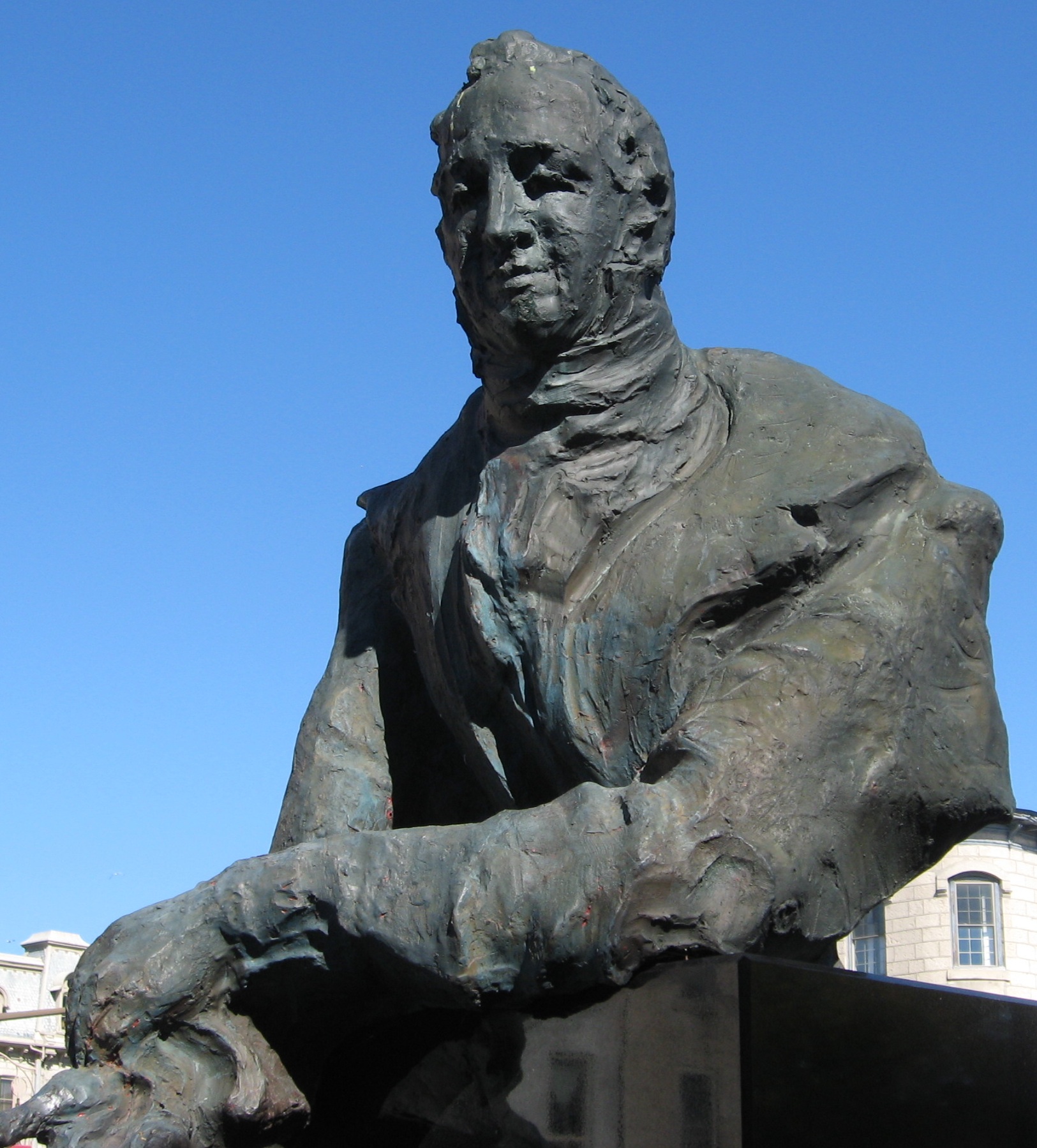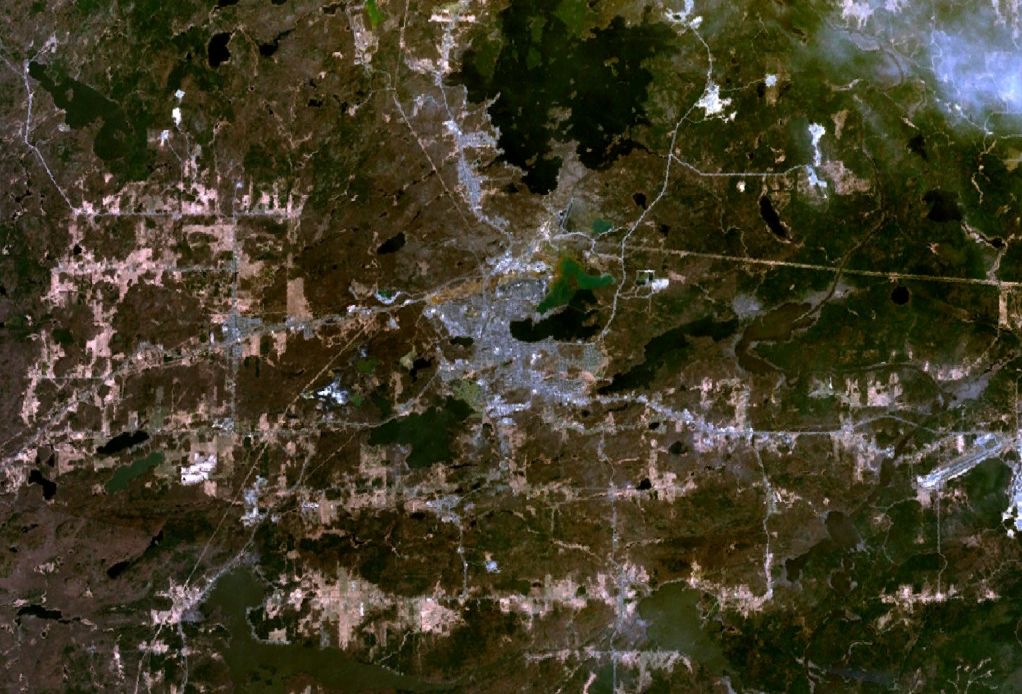|
Kipawa River
The Kipawa River (in French: ''Rivière Kipawa'') is a short river in western Quebec, Canada. It is mostly an undeveloped river but the larger lakes have dams, fishing camps, and cottages on their shores. The communities of Kipawa and Laniel are located on Lake Kipawa. Also much logging takes place within its watershed basin, which is consequently crisscrossed by many bush roads. Route 101 crosses the river at Laniel. The Kipawa River drops over the last from Lake Kipawa to its mouth which results in many whitewater rapids, making it popular with kayakers and canoeists. Since 1986, the Kipawa River Rally has been held annually over this stretch of the river. Its name is derived from the Anishnabe word "''Kebaouek''" meaning "at the narrows beyond which more water opens out". Significant lakes (in downstream order) *Grassy Lake (Lac aux Foins) *Watson Lake *Wolf Lake (Lac des Loups) *Lac Sairs *Grindstone Lake *Hunter Lake *Lake Kipawa Significant tributaries *Audoin River * ... [...More Info...] [...Related Items...] OR: [Wikipedia] [Google] [Baidu] |
Anishnabe
The Anishinaabeg (adjectival: Anishinaabe) are a group of culturally related Indigenous peoples present in the Great Lakes region of Canada and the United States. They include the Ojibwe (including Saulteaux and Oji-Cree), Odawa, Potawatomi, Mississaugas, Nipissing and Algonquin peoples. The Anishinaabe speak ''Anishinaabemowin'', or Anishinaabe languages that belong to the Algonquian language family. At the time of first contact with Europeans they lived in the Northeast Woodlands and Subarctic, and some have since spread to the Great Plains. The word Anishinaabe translates to "people from whence lowered". Another definition refers to "the good humans", meaning those who are on the right road or path given to them by the Creator Gitche Manitou, or Great Spirit. Basil Johnston, an Ojibwe historian, linguist, and author wrote that the term's literal translation is "Beings Made Out of Nothing" or "Spontaneous Beings". The Anishinaabe believe that their people were crea ... [...More Info...] [...Related Items...] OR: [Wikipedia] [Google] [Baidu] |
Canoe
A canoe is a lightweight narrow water vessel, typically pointed at both ends and open on top, propelled by one or more seated or kneeling paddlers facing the direction of travel and using a single-bladed paddle. In British English, the term ''canoe'' can also refer to a kayak, while canoes are called Canadian or open canoes to distinguish them from kayaks. Canoes were developed by cultures all over the world, including some designed for use with sails or outriggers. Until the mid-19th century, the canoe was an important means of transport for exploration and trade, and in some places is still used as such, sometimes with the addition of an outboard motor. Where the canoe played a key role in history, such as the Northern United States, Canada, and New Zealand, it remains an important theme in popular culture. Canoes are now widely used for competition and pleasure, such as racing, whitewater, touring and camping, freestyle and general recreation. Canoeing has been part ... [...More Info...] [...Related Items...] OR: [Wikipedia] [Google] [Baidu] |
Natural Resources Canada
Natural Resources Canada (NRCan; french: Ressources naturelles Canada; french: RNCan, label=none)Natural Resources Canada is the applied title under the Federal Identity Program; the legal title is Department of Natural Resources (). is the department of the Government of Canada responsible for natural resources, energy, minerals and metals, forests, earth sciences, mapping, and remote sensing. It was formed in 1994 by amalgamating the Department of Energy, Mines and Resources with the Department of Forestry. Under the ''Constitution Act, 1867'', primary responsibility for natural resources falls to provincial governments, however, the federal government has jurisdiction over off-shore resources, trade and commerce in natural resources, statistics, international relations, and boundaries. The department administers federal legislation relating to natural resources, including energy, forests, minerals and metals. The department also collaborates with American and Mexican governme ... [...More Info...] [...Related Items...] OR: [Wikipedia] [Google] [Baidu] |
List Of Rivers Of Quebec
This is a list of rivers of Quebec. Quebec has about: *one million lakes of which 62279 have a toponymic designation (a name), plus 218 artificial lakes; *15228 watercourses with an official toponymic designation, including 12094 streams and 3134 rivers. Quebec has 2% of all fresh water on the planet."''Du Québec à la Louisiane, sur les traces des Français d'Amérique'', Géo Histoire, Hors-série, Éditions Prisma, Paris, October 2006 James Bay watershed James Bay Rivers flowing into James Bay, listed from south to north * Rivière au Saumon (Baie James) * Rivière au Phoque (Baie James) * Désenclaves River * Roggan River **Corbin River ** Anistuwach River * Kapsaouis River * Piagochioui River =Tributaries of La Grande River= =Tributaries of Rupert River= =Tributaries of Broadback River= =Tributaries of Nottaway River= Tributaries of Waswanipi River (which empties in Nottaway River via Matagami Lake) Tributaries of Bell River Quebec rivers flowing in Ontario (o ... [...More Info...] [...Related Items...] OR: [Wikipedia] [Google] [Baidu] |
Snow Fence
A snow fence, similar to a sand fence, is a barrier that forces windblown, drifting snow to accumulate in a desired place. They are primarily employed to minimize the amount of snowdrift on roadways and railways. Farmers and ranchers use snow fences to create drifts in basins for a ready supply of water in the spring. Ski resorts also use snow fences in order to increase snow depth in specified areas, or for avalanche control. Description and physical mechanism Temporary snow fences are usually one of two varieties: perforated orange plastic sheeting attached to stakes at regular intervals (the type usually used for construction site fencing or temporary sports field fencing), or a cedar or other lightweight wood strip and wire fence, also attached to metal stakes. A permanent snow fence usually consists of poles with horizontal planks running across them so that they cover just over one-half of the total fence area. The bottom 10% to 15% of the fence should be left open so tha ... [...More Info...] [...Related Items...] OR: [Wikipedia] [Google] [Baidu] |
Hydro-Québec
Hydro-Québec is a public utility that manages the generation, transmission and distribution of electricity in the Canadian province of Quebec, as well as the export of power to portions of the Northeast United States. It was established by the Government of Quebec in 1944 from the expropriation of private firms. This was followed by massive investment in hydro-electric projects like the James Bay Project. Today, with 63 hydroelectric power stations, the combined output capacity is 37,370 megawatts. Extra power is exported from the province and Hydro-Québec supplies 10 per cent of New England's power requirements. Hydro-Québec is a Crown corporation (state-owned enterprise) based in Montreal. In 2018, it paid CAD$2.39 billion in dividends to its sole shareholder, the Government of Québec. Its residential power rates are among the lowest in North America. More than 40 percent of Canada’s water resources are in Québec and Hydro-Québec is the fourth largest hydropower produ ... [...More Info...] [...Related Items...] OR: [Wikipedia] [Google] [Baidu] |
Guelph, Ontario
Guelph ( ; 2021 Canadian Census population 143,740) is a city in Southwestern Ontario, Canada. Known as "The Royal City", Guelph is roughly east of Kitchener and west of Downtown Toronto, at the intersection of Highway 6, Highway 7 and Wellington County Road 124. It is the seat of Wellington County, but is politically independent of it. Guelph began as a settlement in the 1820s, established by Scotsman John Galt, who was in Upper Canada as the first Superintendent of the Canada Company. He based the headquarters, and his home, in the community. The area – much of which became Wellington County – had been part of the Halton Block, a Crown Reserve for the Six Nations Iroquois. Galt would later be considered as the founder of Guelph. For many years, Guelph ranked at or near the bottom of Canada's crime severity list. However, the 2017 Crime Severity Index showed a 15% increase from 2016. Guelph has been noted as having one of the lowest unemployment rates in the ... [...More Info...] [...Related Items...] OR: [Wikipedia] [Google] [Baidu] |
Canadian Heritage Rivers System
The Canadian Heritage Rivers System (CHRS; french: Le réseau de rivières du patrimoine canadien) is a joint program administered by the federal, provincial and territorial governments to conserve and protect the best examples of Canada's river heritage, to give them national recognition, and to encourage the public to enjoy and appreciate them. It is a cooperative program of the governments of Canada, nine provinces, and the three territories. A 14-member national board, created under the Parks Canada Agency Act, administers the program and approves the designation of specific rivers. History The Canadian Heritage Rivers System was established in 1984. The first Canadian Heritage River was the French River in Ontario, designated in 1986. By 1996 there were 29 designated rivers. Quebec withdrew its participation in 2006. There are currently 39 designated and three nominated rivers; with rivers designated in every province and territory except for Quebec. Designated rivers The ... [...More Info...] [...Related Items...] OR: [Wikipedia] [Google] [Baidu] |
National Holiday (Quebec)
Saint-Jean-Baptiste Day (french: Fête de la Saint-Jean-Baptiste, la Saint-Jean, Fête nationale du Québec), also known in English as ''St John the Baptist Day'', is a holiday celebrated on June 24 in the Canadian province of Quebec and by French Canadians across Canada and the United States. It was brought to Canada by French settlers celebrating the traditional feast day of the Nativity of Saint John the Baptist. It was declared a public holiday in QuebecQuébec 'national Holiday Act' defining the holiday, http://www2.publicationsduquebec.gouv.qc.ca/dynamicSearch/telecharge.php?type=2&file=%2F%2FF_1_1%2FF1_1_A.htmGouvernement du Québec.National Holiday", in the site of the ''Commission des normes du travail'', June 17, 2008. Retrieved June 29, 2008Gouvernement du Québec., in ''CanLII'', Federation of Law Societies of Canada, updated to May 1, 2008. Retrieved June 29, 2008 in 1925, with publicly financed events organized province-wide by a ''Comité organisateur de la fête nat ... [...More Info...] [...Related Items...] OR: [Wikipedia] [Google] [Baidu] |
Rouyn-Noranda, Quebec
Rouyn-Noranda ( 2021 population 42,313) is a city on Osisko Lake in the Abitibi-Témiscamingue region of Quebec, Canada. The city of Rouyn-Noranda is a coextensive with a territory equivalent to a regional county municipality (TE) and census division (CD) of Quebec of the same name. Their geographical code is 86. History The city of Rouyn (named for Jean-Baptiste Rouyn, a captain in the Régiment Royal Roussillon of Louis-Joseph de Montcalm) appeared after copper was discovered in 1917. Noranda (a contraction of "North Canada") was created later around the Horne mine and foundry. Both were officially constituted as cities in 1926, then merged in 1986. Since 1966, Rouyn and Noranda constitute the capital of the Abitibi-Témiscamingue region. It is also the seat of Université du Québec en Abitibi-Témiscamingue (UQAT) since 1983. The population tends to increase or decrease dramatically depending on the economic situation. The city's population dropped by 5 per cent be ... [...More Info...] [...Related Items...] OR: [Wikipedia] [Google] [Baidu] |
Log Driving
Log driving is a means of moving logs (sawn tree trunks) from a forest to sawmills and pulp mills downstream using the current of a river. It was the main transportation method of the early logging industry in Europe and North America. History When the first sawmills were established, they were usually small water-powered facilities located near the source of timber, which might be converted to grist mills after farming became established when the forests had been cleared. Later, bigger circular sawmills were developed in the lower reaches of a river, with the logs floated down to them by log drivers. In the broader, slower stretches of a river, the logs might be bound together into timber rafts. In the smaller, wilder stretches of a river where rafts couldn't get through, masses of individual logs were driven down the river like huge herds of cattle. "Log floating" in Sweden (''timmerflottning'') had begun by the 16th century, and 17th century in Finland (''tukinuitto''). T ... [...More Info...] [...Related Items...] OR: [Wikipedia] [Google] [Baidu] |
Algonquin People
The Algonquin people are an Indigenous people who now live in Eastern Canada. They speak the Algonquin language, which is part of the Algonquian language family. Culturally and linguistically, they are closely related to the Odawa, Potawatomi, Ojibwe (including Oji-Cree), Mississauga and Nipissing, with whom they form the larger Anicinàpe (Anishinaabeg). Algonquins call themselves Omàmiwinini (plural: Omàmiwininiwak) or the more generalised name of Anicinàpe. Though known by several names in the past, such as ''Algoumequin'', the most common term "Algonquin" has been suggested to derive from the Maliseet word (): "they are our relatives/allies." The much larger heterogeneous group of Algonquian-speaking peoples, who, according to Brian Conwell, stretch from Virginia to the Rocky Mountains and north to Hudson Bay, was named after the tribe. Most Algonquins live in Quebec. The nine recognized status Algonquin bands in that province and one in Ontario have a combined ... [...More Info...] [...Related Items...] OR: [Wikipedia] [Google] [Baidu] |






